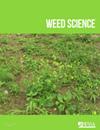Resistance patterns and molecular basis to ACCase-inhibiting herbicides in Digitaria ciliaris var. chrysoblephara from China
IF 2.1
2区 农林科学
Q2 AGRONOMY
引用次数: 0
Abstract
Digitaria ciliaris var. chrysoblephara (Fig. & De Not.) R.R. Stewart is an annual xeromorphic weed that severely infests direct-seeded rice fields in China. Herbicide resistance is emerging in D. ciliaris var. chrysoblephara owing to extensive and recurrent use of acetyl-CoA carboxylase (ACCase)-inhibiting herbicide metamifop. In this study, a total of 53 D. ciliaris var. chrysoblephara populations randomly sampled from direct-seeded rice fields across Jiangsu Province were investigated for metamifop resistance and potential resistance-endowing mutations. Single-dose assays revealed that 17 (32.1%) populations evolved resistance to metamifop and 5 (9.4%) populations were in the process of developing resistance. Resistance index (RI) of metamifop-resistant populations ranged from 2.7 to 32.1. Amino acid substitutions (Ile-1781-Leu, Trp-2027-Cys/Ser, and Ile-2041-Asn) in ACCase genes were detected in resistant D. ciliaris var. chrysoblephara plants, and caused various cross-resistance patterns to ACCase-inhibiting herbicides. All of four resistant populations (YC07, YZ09, SQ03, and HA06), with different ACCase mutations, exhibited cross-resistance to the aryloxyphenoxypropionate (APP) herbicides cyhalofop-butyl (RIs, 10.0 to 19.9), fenoxaprop-P-ethyl (RIs, 53.7 to 132.8), and haloxyfop-P-methyl (RIs, 6.2 to 62.6), and the phenylpyrazoline (DEN) pinoxaden (RIs, 2.3 to 5.4), but responded differently to the cyclohexanedione (CHD) herbicides clethodim and sethoxydim. It is noteworthy that four post-emergence herbicides used for rice cropping, including bispyribac-sodium, pyraclonil, quinclorac, and anilofos, showed poor control effect against D. ciliaris var. chrysoblephara, suggesting few alternations for managing this weed in rice fields except ACCase inhibitors. In conclusion, this work demonstrated that the D. ciliaris var. chrysoblephara had developed resistance to ACCase-inhibiting herbicides in rice cultivation of China, and target-site amino acid substitutions in ACCase were primarily responsible for metamifop resistance.中国蟋蟀草(Digitaria ciliaris var. Chrysoblephara)对ACC酶抑制性除草剂的抗性模式和分子基础
Digitaria ciliaris var. Chrysoblephara (Fig. & De Not.) R.R. Stewart 是一种一年生异型杂草,严重危害中国的直播稻田。由于乙酰-CoA羧化酶(ACCase)抑制性除草剂甲草胺的广泛和反复使用,D. ciliaris var. Chrysoblephara 对除草剂的抗性正在出现。本研究从江苏省各地的直播稻田中随机抽样选取了53个D. ciliaris var. Chrysoblephara种群,对其甲磺草胺抗性和潜在的抗性突变进行了调查。单剂量测定结果显示,17 个种群(32.1%)对甲氰菊酯产生了抗性,5 个种群(9.4%)正在产生抗性。甲胺磷抗性种群的抗性指数(RI)从 2.7 到 32.1 不等。在抗性 D. ciliaris var. Chrysoblephara 植株中检测到 ACCase 基因中的氨基酸取代(Ile-1781-Leu、Trp-2027-Cys/Ser 和 Ile-2041-Asn),并导致对 ACCase 抑制性除草剂产生不同的交叉抗性。四个抗性种群(YC07、YZ09、SQ03 和 HA06)都有不同的 ACCase 突变,它们对芳基氧基苯氧基丙酸酯(APP)除草剂氰氟草酯(RIs,10.0 至 19.9)、精噁唑禾草灵(RIs,53.7 至 132.8)表现出交叉抗性。但对环己二酮除草剂 clethodim 和 sethoxydim 的反应则不同。值得注意的是,用于水稻种植的四种芽后除草剂,包括双草醚、吡唑醚菌酯、喹草酮和苯胺磷,对 D. ciliaris var. Chrysoblephara 的控制效果不佳,这表明除了 ACCase 抑制剂外,几乎没有其他替代品可用于管理水稻田中的这种杂草。总之,该研究表明,在中国的水稻种植中,D. ciliaris var. Chrysoblephara对ACC酶抑制性除草剂产生了抗性,而ACC酶的靶位氨基酸取代是造成甲磺草胺抗性的主要原因。
本文章由计算机程序翻译,如有差异,请以英文原文为准。
求助全文
约1分钟内获得全文
求助全文
来源期刊

Weed Science
农林科学-农艺学
CiteScore
4.60
自引率
12.00%
发文量
64
审稿时长
12-24 weeks
期刊介绍:
Weed Science publishes original research and scholarship in the form of peer-reviewed articles focused on fundamental research directly related to all aspects of weed science in agricultural systems. Topics for Weed Science include:
- the biology and ecology of weeds in agricultural, forestry, aquatic, turf, recreational, rights-of-way and other settings, genetics of weeds
- herbicide resistance, chemistry, biochemistry, physiology and molecular action of herbicides and plant growth regulators used to manage undesirable vegetation
- ecology of cropping and other agricultural systems as they relate to weed management
- biological and ecological aspects of weed control tools including biological agents, and herbicide resistant crops
- effect of weed management on soil, air and water.
 求助内容:
求助内容: 应助结果提醒方式:
应助结果提醒方式:


